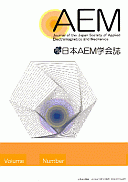Volume 30, Issue 1
Displaying 1-9 of 9 articles from this issue
- |<
- <
- 1
- >
- >|
Introduction to the Volume 30 of Journal of the Japan Society of Applied Electromagnetics and Mechanics
-
2022Volume 30Issue 1 Pages 1-
Published: 2022
Released on J-STAGE: April 20, 2022
Download PDF (389K)
Special Topic: Power Electronics Technology for Practical Applications
-
2022Volume 30Issue 1 Pages 2-8
Published: 2022
Released on J-STAGE: April 20, 2022
Download PDF (5102K) -
2022Volume 30Issue 1 Pages 9-14
Published: 2022
Released on J-STAGE: April 20, 2022
Download PDF (3167K) -
2022Volume 30Issue 1 Pages 15-22
Published: 2022
Released on J-STAGE: April 20, 2022
Download PDF (2308K) -
2022Volume 30Issue 1 Pages 23-26
Published: 2022
Released on J-STAGE: April 20, 2022
Download PDF (1652K) -
2022Volume 30Issue 1 Pages 27-32
Published: 2022
Released on J-STAGE: April 20, 2022
Download PDF (3779K) -
2022Volume 30Issue 1 Pages 33-38
Published: 2022
Released on J-STAGE: April 20, 2022
Download PDF (2534K) -
2022Volume 30Issue 1 Pages 39-44
Published: 2022
Released on J-STAGE: April 20, 2022
Download PDF (3307K)
Book Review
-
2022Volume 30Issue 1 Pages 45-
Published: 2022
Released on J-STAGE: April 20, 2022
Download PDF (342K)
- |<
- <
- 1
- >
- >|
